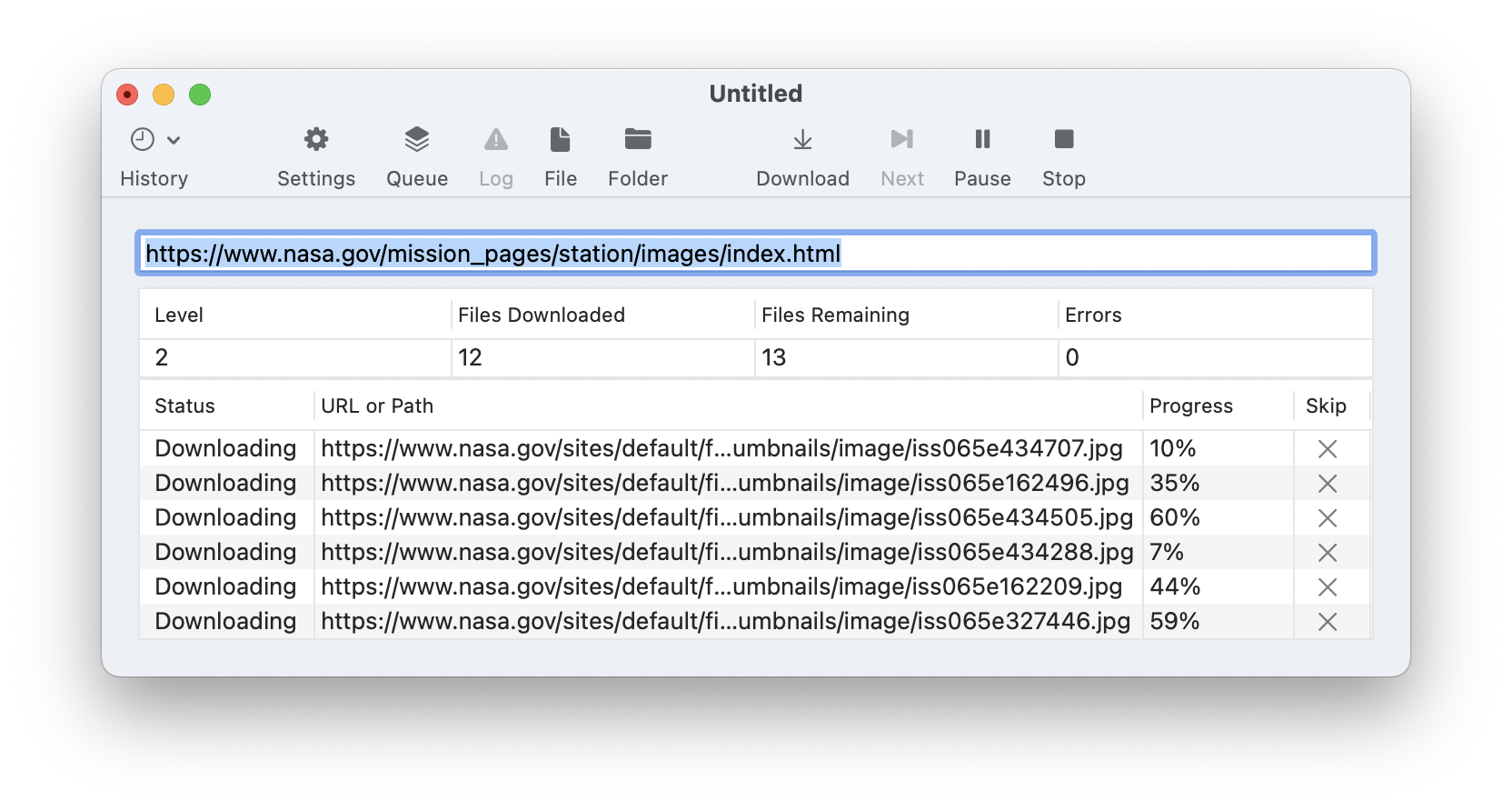Overview
SiteSucker is a Macintosh application that automatically downloads websites from the Internet. It does this by copying the site's webpages, style sheets, images, PDFs, and other files to your local hard drive, duplicating the site's directory structure. By default, SiteSucker "localizes" the files it downloads, allowing you to browse a site offline.
SiteSucker Pro is an enhanced version of SiteSucker that can download embedded videos, including embedded YouTube and Vimeo videos. To learn more about SiteSucker Pro, visit the SiteSucker Pro Features page.
The SiteSucker window shows the URL (Uniform Resource Locator) being downloaded, the current status of the download, and the toolbar.

To start downloading a site:
- Enter an Internet address into the URL text field.
- Press ↩ and SiteSucker will go to work.
SiteSucker provides several convenient ways to enter an address to download. For example, you can choose a recently used URL from the History menu or a bookmark from the Bookmarks menu. You can also choose File → Share → SiteSucker in a web browser to send the URL of the current page to SiteSucker.
If the downloaded file is a webpage or style sheet, SiteSucker will scan the file for links and download the links. While downloading, status messages are displayed in the SiteSucker window. When SiteSucker exhausts all links, it will stop automatically. To stop the download manually, click the Stop button in the toolbar.
Use the Open File item in the File menu or click the File button in the toolbar to open a file that you recently downloaded. To open the folder containing all downloaded files, use the Open Destination Folder item in the File menu or click the Folder button in the toolbar. In the destination folder, you'll find log files and folders containing downloaded websites. These folders may also include a _downloads.html file. Whenever you start a download, a link to the first file downloaded is added to this file, up to a maximum of forty links. If you open _downloads.html in a web browser, you can see your downloaded files by clicking on these links. You can use the Open Downloads item in the File menu to open the _downloads.html file for any downloaded site in the destination folder of the active document.
When SiteSucker downloads a resource from the web, it also sets the Where from extended attribute for the file, which identifies the URL that was used to download the file. To see this attribute, select the downloaded file in the Finder, choose File → Get Info, and look for the Where from field under More Info in the window.
When SiteSucker localizes sites, it creates links that are all relative to files in the destination folder. For this reason, the entire contents of the destination folder can be moved to any location without breaking any links, provided that no item being moved is renamed.
To download multiple sites, you can open multiple SiteSucker windows or use the queue to download a series of sites within a window. To download a password protected site, SiteSucker provides a web browser that allows you to log in to the site before starting the download.
Each SiteSucker window represents a document. The number of simultaneous Internet connections for new SiteSucker documents is determined by a setting in the preferences. Each SiteSucker document has its own settings. New SiteSucker documents are assigned the user default settings. SiteSucker settings allow you to tailor the download by specifying the destination folder, logging options, file limits, allowed paths, allowed file types, etc. You can even download a site as a PDF document using the Create PDF setting in the Webpage settings.
You can use the Save or Save As item in the File menu to save the contents of a SiteSucker window as a document. This saves all the information about a download, including the URL, the settings, and the queue. You can then use the document to perform the same download whenever you want. If SiteSucker is in the middle of a download when you choose the Save item, SiteSucker will pause the download and save its status with the document. Later, you can restart the download from where it left off by opening the document and pressing the Resume button in the toolbar.
Finally, many advanced topics related to SiteSucker are also discussed in this manual. For example, the Transferring Files page explains how SiteSucker allows you to transfer downloaded sites between your Macintosh and your iOS device using AirDrop, iCloud Drive, Dropbox, or the Finder. If you're having trouble using SiteSucker, you may find a solution on the Frequently Asked Questions page.
